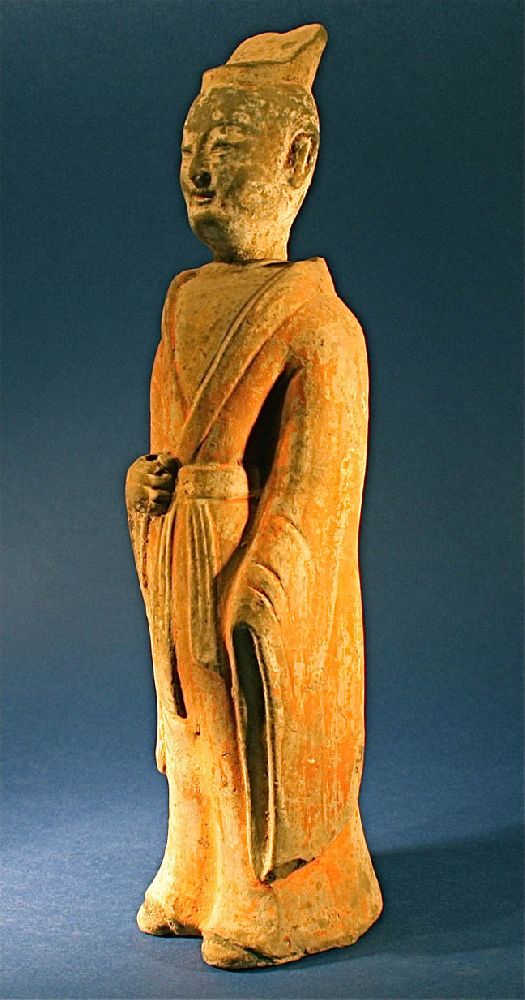

Title: Old Dynasty Pottery Chinese Ancient Earthenware Clay Warrior
Shipping: $29.00
Artist: N/A
Period: Antiquity
History: N/A
Origin: N/A
Condition: Excellent
Item Date: 206 B.c. - 220 AD
Item ID: 4546
An Eastern-Han pottery soldier, with a now-faded coating of paint. Exquisite example of Dynasty pottery that we believe was excavated from in a tomb in China. Beautiful terra cota color and aged patina. A very rare find. Pottery is made by forming a clay body into objects of a required shape and heating them to high temperatures in a kiln to induce reactions that lead to permanent changes, including increasing their strength and hardening and setting their shape. There are wide regional variations in the properties of clays used by potters and this often helps to produce wares that are unique in character to a locality. It is common for clays and other minerals to be mixed to produce clay bodies suited to specific purposes. Clay bodies are said to be "bone-dry" when they reach a moisture content at or near 0%. Unfired objects are often termed greenware. Clay bodies at this stage are very fragile and hence can be easily broken. The quality of pottery has varied historically, in part dependent upon the repute in which the potter's craft was held by the community.
Link: http://en.wikipedia.org/wiki/Chinese_art
Terracotta, Terra cotta or Terra-cotta (Italian: "baked earth", from the Latin terra cocta) is a clay-based unglazed ceramic, although the term can also be applied to glazed ceramics where the fired body is porous and red in color. Its uses include vessels, water and waste water pipes and surface embellishment in building construction, along with sculpture such as the Terracotta Army and Greek terracotta figurines. The term is also used to refer to items made out of this material and to its natural, brownish orange color, which varies considerably. In archaeology and art history, "terracotta" is often used of objects not made on a potter's wheel, such as figurines, where objects made on the wheel from the same material, possibly even by the same person, are called pottery; the choice of term depending on the type of object rather than the material[citation needed]. Chinese art (Chinese: has varied throughout its ancient history, divided into periods by the ruling dynasties of China and changing technology. Different forms of art have been influenced by great philosophers, teachers, religious figures and even political leaders. Chinese art encompasses fine arts and folk arts. Early forms of art in China were made from pottery and jade in the Neolithic period, to which was added bronze in the Shang Dynasty. The Shang are most remembered for their blue casting, noted for its clarity of detail.In early imperial China, porcelain was introduced and was refined to the point that in English the word china has become synonymous with high-quality porcelain. Around the 1st century AD, Buddhism arrived in China, though it did not become popular until the 4th century. At this point, Chinese Buddhist art began to flourish, a process which continued through the 20th century. It was during the period of Imperial China that calligraphy and painting became highly appreciated arts in court circles, with a great deal of work done on silk until well after the invention of paper. Buddhist architecture and sculpture thrived in the Sui and Tang dynasty. Of which, the Tang Dynasty was particularly open to foreign influence. Buddhist sculpture returned to a classical form, inspired by Indian art of the Gupta period. Towards the late Tang dynasty, all foreign religions were outlawed to support Taoism. In the Song dynasty, paintings of more subtle expression of landscapes appeared, with blurred outlines and mountain contours which conveyed distance through an impressionistic treatment of natural phenomena. It was during this period that in painting, emphasis was placed on spiritual rather than emotional elements, as in the previous period. In the Yuan dynasty, painting by the Chinese painter Zhao Mengfu (趙åŸé «) greatly influenced later Chinese landscape painting. Under efforts of masters from the Shanghai School during the late Qing Dynasty, traditional Chinese art reached another climax and continued to the present in forms of the "Chinese painting" (guohua, 國畫). The Shanghai School challenged and broke the literati tradition of Chinese art, while also paying technical homage to the ancient masters and improving on existing traditional techniques.